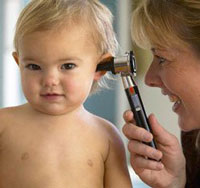http://hearinghealthmatters.org/hearingviews/2013/tis-season-gift-hearing/



The Washington Children's Hearing Aid Alliance is a volunteer advocacy group. Our mission is to ensure all children with hearing loss have access to quality and affordable hearing care in the state of Washington.






|
| |||||||
 Even if a child is hearing well, a child with hearing loss is listening through a damaged auditory system. We know that a child with hearing loss needs four times the repetition to learn. So we know that in a classroom situation, a child with hearing loss will need to hear everything multiple times to get the message. What does this tell us about how a child is learning? It tells us that we need to be sure a child has the information he needs to follow classroom discussion. To me this means that a child needs preview and review by a person who has academic skills. Usually this is a teacher of children with hearing loss. It may be a speech-language pathologist who provides the service, and this can work well for young children, but may not be optimal for older children where academic material is more difficult. The SLP will also be responsible for teaching all speech and language skills so, if the SLP is responsible for preview and review, more time needs to be allotted to service provision.
Even if a child is hearing well, a child with hearing loss is listening through a damaged auditory system. We know that a child with hearing loss needs four times the repetition to learn. So we know that in a classroom situation, a child with hearing loss will need to hear everything multiple times to get the message. What does this tell us about how a child is learning? It tells us that we need to be sure a child has the information he needs to follow classroom discussion. To me this means that a child needs preview and review by a person who has academic skills. Usually this is a teacher of children with hearing loss. It may be a speech-language pathologist who provides the service, and this can work well for young children, but may not be optimal for older children where academic material is more difficult. The SLP will also be responsible for teaching all speech and language skills so, if the SLP is responsible for preview and review, more time needs to be allotted to service provision.| Source: Google Images |
 |
| Image Source: www.nidcd.nih.gov |
| Source: Google images |
 |
| Image Source: Wikipedia |
| Example of a cochlear implant (source: cochlear implant images on Google) |
 |
| Image Source: Wikipedia |
"In an online version of the journal Pediatrics (http://pediatrics.aappublications.org) for April 15, 2013, more evidence was found that the sound of music could be beneficial for newborns. It was found that premature babies in the neonatal intensive care unit (NICU) who had respiratory difficulties did slightly better when presented with recorded sounds of what their mother’s voice would have sounded like in the womb. Similar findings were found whenever the mother or father sang to them. The heart rate of these infants slowed by 2-3 beats a minute while listening to these sounds.
Specifically, from data acquired at 11 NICUs that had music therapists employed, for 272 premature infants, over a two-week period, a number of vital signs were recorded. It turns out that the reduction in heart rate was the same whether the low-frequency sound was provided by a music therapist’s device or by the voice of the parents.
This is more evidence that music (singing) can be beneficial for even our youngest members of society. For years, parents have been told to talk to their unborn and newborn children in hopes of developing early bonds.Read the full post on HHTM: Infants and The Vowel U
... "
 |
| Image source: Wikipedia |
 |
| Image Source: Wikipedia |
 |
| Image Source: Infanthearing.org |
 |
Image courtesy S. Miles at FreeDigitalPhotos.net |
"I was born with a severe to profound hearing loss and rely on a pair of hearing aids to bring sound into my life. My work requires me to travel a great deal and I certainly can sleep very well anywhere in the world no matter how close the hotel room is to the elevator. That said, I am grateful that I can listen and talk. Hearing is fundamental to language. Language is what connects us to other people and is the foundation of everything we do in life."
"My hearing loss was identified when I was very young and I was provided with hearing aids and support services in the United States during the crucial early years of my development. This support enabled me to learn to communicate through spoken language and grow up to participate fully in our hearing society. It did not seem right to me that many children with hearing loss in other parts of the world would not have same opportunities in life simply because of where they are born. I founded the Global Foundation For Children With Hearing Loss to help change that. The Global Foundation is a nonprofit organization that helps children with hearing loss in developing and emerging countries access the hearing technology, educational support, and resources they need to reach their potential in our hearing world. Since 2010, the Global Foundation has been working to provide support to children with hearing loss in Vietnam."
.....
 |
| Image Source: Wikipedia |
 |
| Image source: Wikipedia |
“With public and private support, a public-education campaign is being developed to raise awareness about safe use of personal music players . . . and risks of loud and long listening,” said Nancy Clark, the city Health Department’s assistant commissioner of environmental-disease prevention.
The campaign, which will cost $250,000, is being financed through a grant received from the Fund for Public Health, the Health Department’s fund-raising arm.
The Hearing Loss Prevention Media Campaign will target teens and young adults, conducting focus-group interviews and using social-media sites like Facebook and Twitter.
Bloomberg has had a bug about ear-splitting rackets since taking office at City Hall, making noise reduction one of his key quality-of-life initiatives. In 2005, he signed a law — “Operation Silent Night” — overhauling the noise code. It cracked down on jolting jackhammer sounds at construction sites and on music blaring out of clubs, helping “make New York quieter and more liveable.”Read the full story: http://www.nypost.com/p/news/local/mayor_deaf_jammer_S37gCMR9xUDKw2vx9bjFVM
"Did you know that hearing aids aren’t covered by insurance in most states? Did you know that hearing aids cost about $2500 each and need to be replaced every 3-5 years, especially for children? [...]
"These costs add up quickly for families of children with hearing loss, especially when you are paying for other therapies and issues that your child might be dealing with."
"We have the best insurance out there, and none of this is covered."Please read the full post on her blog: http://thenotsosupermama.com/2013/02/21/let-our-children-hear/
 |
| Image Source: Wikipedia |
"Health care reform opponents hate the idea of mandated benefits. From a free market purist’s standpoint it’s a bad idea to tell health insurers what they need to include in their products because it will tend to drive up costs and interfere with the ability of suppliers to meet market demand. This opposition to mandated benefits is a major reason that so many in the GOP are enamored of the idea of allowing health plans to sell policies across state lines."
"As someone with an undergraduate degree in economics and an MBA, I really and truly do understand this free market argument and am sympathetic to it. But it’s important to take more than free market orthodoxy into account when making policy decisions..."
Citizens have another way to interact with their legislators thanks to a new online commenting system launched last week.
Instead of having to determine which legislators serve their district and tracking down an email address or phone number, constituents can simply click a “comment on this bill” link on the bill’s webpage. They will be directed to a page where they can input their email and home addresses. The website automatically will determine the constituent’s district and send a message to the corresponding legislators.If you feel as strongly as we do that hearing loss is a condition that deserves covered treatment and that people (especially children) with hearing loss should have some form of insurance coverage for hearing aids, then please click below:
 Hearing loss is a medical condition that deserves insurance coverage in the same way that diabetes or any other illness would typically be covered for treatment. This is especially true when it comes to children. Any delays in getting hearing aids for a child in need could mean the difference between a child going into the mainstream classroom or possibly needing Special Education services.
Hearing loss is a medical condition that deserves insurance coverage in the same way that diabetes or any other illness would typically be covered for treatment. This is especially true when it comes to children. Any delays in getting hearing aids for a child in need could mean the difference between a child going into the mainstream classroom or possibly needing Special Education services. In its present form, the bill would require health insurance plans to cover a portion of hearing aids purchased for children and adults in the state of Washington. We urge all of our supporters to please contact their legislator and encourage them to support and co-sponsor this type of legislation.
In its present form, the bill would require health insurance plans to cover a portion of hearing aids purchased for children and adults in the state of Washington. We urge all of our supporters to please contact their legislator and encourage them to support and co-sponsor this type of legislation.